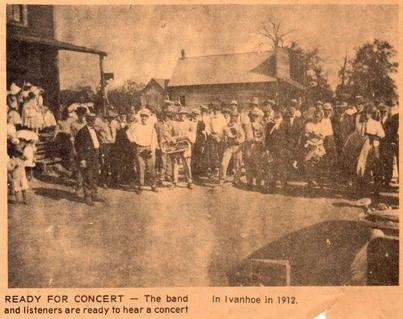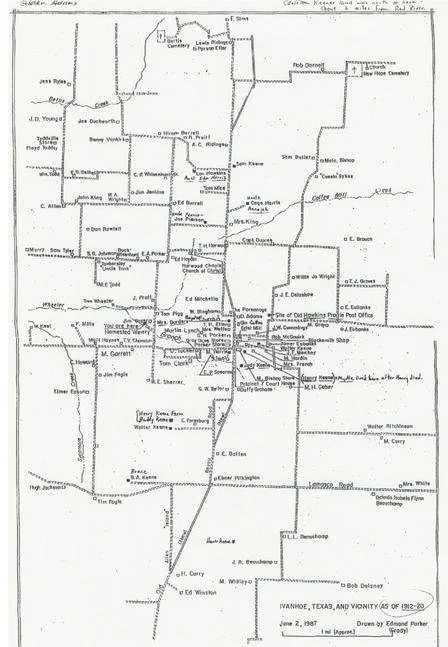Ivanhoe
1909 Ivanhoe. Photo from the Fannin County Museum of History
The following article is from the Bonham Daily Favorite, July 19, 1992
Historic Ivanhoe
By John Frair
The lodge, that will be filled with music and dancers on a weekend night, sits stately atop a 100-foot bluff overlooking Red River. A red clay dam holds back the lake waters dotted with rental boats and fishermen on a summer day.
Along the lake's edge is the boat house with its stone pillars. Next to it, a sand filled swimming beach. There are lights ready to reflect off the still water until late at night. Adventurous youngsters pick through the rocks to find long discarded Indian arrow and spear heads.
The roughly hand-hewed log cabins sit shaded under the oak and cedar trees making up the campground of Lake Fannin Park just north of the Ivanhoo city limits. The electrical fixtures in the cabins are all hand-made from copper worked in a blacksmith shop set up on the premises in the late 1930s.
Ivanhoe resident T.C. Dickey, last concessionist under contract with the government to oversee the operation of the park during the late 1950s, remembers when the campgrounds were full of campers, the lodge filled with teenagers for a weekend dance and the surrounding woods blinking with the light of campfires and of bonfires for wiener roasts after hay rides from Bonham and the surrounding communities.
The prairie just outside the park has also been changed over time and by its use. The prairie in north Fannin County was described in the early 1800s, as covered with a growth of luxurious prairie grass waist high and interspersed with flowers of every color and odor, from cardinal red to spotless white. According to a report in the 1888 Bonham News Annual, the early prairie was “ haunted by wild beasts and transversed by wandering Comanche and Kiowa who roamed through woodland and o’er prairie in search of the long-horned elk, the powerful buffalo, the bounding deer and occasionally laying aside the pipe of peace, took up the tomahawk and buried it in the brain of his pale-faced brother."
When pioneer Strother Hawkins received the land grant in north Fannin County in 1845 it was for a virgin country teeming with animals and occasional dangers.
William R. Forsborg arriving in the area in the mid 1880s described the prairie as still having grass so tall it was over his saddle's stirrups.
Earlier community settlers called their community Hawkins' Prairie. It lay at the edge of timberland with prairie to the southwest of the community.
It would have retained this name if it had not been refused by the U.S. Post Office. There was already a Hawkins, TX in existence so the name was changed to Ivanhoe. Captain Joe Dupree selected this name because he liked Sir Walter Scott's Gothic tale "Ivanhoe."
Located 10 miles north of Bonham, by the mid 1880s it had grown to two general stores, a hotel, blacksmith and wood shop, a steam mill and gin and a "flourishing* school that met ten months of the year. It was also the seat of the Precinct Sever Court presided over by Joseph Sowell.
Sowell was the son of pioneer and Texas Ranger Joseph Sowell killed at Fort Warren by Coushatta Indians. A session of the district court was to meet at Warren in 1841 and because of the long distance most people had to travel to get there, they was housed at a tavern operated by Captain Sowell and J.S. Scott.
According to Judge J.P. Simpson, “Capt. Sowell had a fine and favorite charger he kept to himself securely locked in the stable, his guest’s horses in a substantial enclosure close by."
That night while the men were drinking and engaging in a "recital of the dangers, narrow escapes and combats with the Indians," they wore disturbed by the neighing and trampling of the horses. A group of twelve Indians cut open the door to the stable and bridled and mounted Sowell’s stallion. They then used the horse to drive the other horses out of the lot through a break in the fence they had made.
The events and Sowell's death was described by Judge J. P. Simpson writing in the 1885 publication, History of Fannin County.
"The Indians had laid down in the fence corners and stationed themselves at the barn armed with bows and arrows, with their horseman on the fine charger in the lot driving the horses out." The men in the tavern "were in high glee and uproar at the house; for they had arrived at a point where every man was a hero, a general, a statesman, or some great man, in his own estimation; hearing the mighty crash and tramp of horses their amusement ended in short meter, all ran for their horses, most of them without guns or pistols. Sowell and Scott ran to the gap laid down by the Indians; Sowell armed with a pistol, Scott with a double-barrel shot gun; Sowell discharged his pistol at them without effect, when they sent a volley of arrows at him, one passing through his stomach and out at his back. He fell at the Indian’s feet, and called Scott to shoot the Indian, and expired without a groan. Scott discharged his gun and one Coushatta fell dead with Capt. Sowell. The other Indians left the horses and fled in every direction."
Sowell's body was taken to the bluff overlooking the Red River just below the mouth of Sandy creek and buried on what became known as 8owell's Bluff, a sbort distance from the Ivanhoe community.
Ivanhoe was described in the 1886 History of Fannin County as having been only, a few years earlier, a place considered hardly worth owning. "It was without population, now for seven miles around it has a dense population, handsome farms, neat houses and industrious people, who have by cultivation, proved that the soil, once considered valueless, is capable of producing well, everything that is planted.”
By the mid 1880s the population had risen to 160 people and the town was called the ‘‘Garden Spot of Texas” by the Texas Farm and Fireside magazine.
The Baptist church was organised in 1872 and by 1884 the Texas Gazetteer lists the community of 200 as having a church, school, grist mill, cotton gin, and stage coach run tri-weekly to Bonham.
Then, J. R Reed was the postmaster and owner of the general store. Others living in the community were J.E. Dupree, lawyer, William R Forsborg, carpenter, E.R Gill, teacher, S. S. Keene, lawyer; James McKee, doctor. A.S. Ridings and Fred Whiley were blacksmiths, J.W. Sowell and Keene owned a general store and John Wolf owned a saw and grist null.
By 1890 the population had dropped to 160 and included J.W. Sowell, owner of a general store; hotel proprietor Joseph Smith; Thomas and Graham, mill and gin; John E. Smith, blacksmith; S. A. Greene and E. Reynolds, doctors.
The early 1900s brought several changes to the community, including the arrival of the Parker, Cummings and Eller families.
Gabe Parker owned a merchandising business that lasted for over 40 years. He also taught in the Ivanhoe school for about fifty years.
J.W. Cummings raised his family in the community and his son Curleo taught school in the county and was county superintendent in the 1930s.
Tom Eller's family established a gin and grocery store. The community’s remaining store is still owned by Janie Eller, daughter-in-law of the elder Eller.
The town, the park, and the prairie have seen drastic changes take place over the years.
The population of Ivanhoe is now only about 90 and the school has been consolidated into the Sam Rayburn District School. The community still has its post office and one store still in operation. Much of the prairie that supported the cotton and grains of the past has now boen converted to pasture.
The 100-plus acre Lake Fannin park also has changed since it was acquired under the 1935 Federal Resettlement Act. Later it fell under the Bankhead-Jones Tenant Act of 1937. The reason of the acquisitions was to rehabilitate the land and to create water recreational facilities.
Besides Lake Fannin the government’s Works Progress Administration was also creating both Lake Crockett and Coffee Mill Lakes. These three projects not only created recreational facilities for north Texas but was used to help get people back working following the “great depression."
But, all public access stopped at the park in the late 1960s when the park was leased to the first of several different church organizations. In the early 1970s it was used by the Ft. Worth Y.M.CA as a summer camp.
The National Forest Service used the facilities for the Youth Conservation Corp. from 1978 to 1980.
The boathouse pillars now sit lonely at the edge of the lake. The remaining facilities, according to Joel Shephard of the National Forest Service, are now unsafe. The park has not been open to the public since 1980.
Still located in the park are eleven cabins, the bath house, caretaker's cabin and the lodge. Several cabins have been destroyed, the latest burned by vandals last year.
Governmental land acquisitions have been expanded outside the lakes to preserve prairie as a national resource. The holdings around the Ivanhoe community now is over 21,000 acres administered as part of the federally protected Caddo Grasslands.
Lake Fannin has now been determined by Texas to be eligible as a historic site according to John Beck, of the National Forest Service. This is the first step in having the area placed on the National Register of Historic Locations.
Beck said, once the park is included in the National Register, it will be protected and restored to its original condition and again open to the public.
Thanks to David Keene for providing this map. See it in a larger format here.


